
The Coat of Arms of Tyrol is the historic coat of arms of the region of Tyrol. It shows a red eagle. It was used by the Princely County of Tyrol and is today used by the states of Tyrol in Austria, South Tyrol in Italy, and numerous municipalities.

The Coat of Arms of Tyrol is the historic coat of arms of the region of Tyrol. It shows a red eagle. It was used by the Princely County of Tyrol and is today used by the states of Tyrol in Austria, South Tyrol in Italy, and numerous municipalities.


The Tyrolean eagle is red on a silver shield, with a golden beak, claws, and "clover-stems" which line the wings. It has been used as a symbol of the region since the early 13th century.
The eagle originates as the hereditary coat of arms of the Counts of Tyrol, who resided at Tyrol Castle, which gave its name to the greater region. The seal of Albert IV, Count of Tyrol, dating from 1205, displays the Tyrolean eagle. It developed independently from the similar Coat of Arms of Brandenburg. The oldest colored representations date to the years 1271 and 1286. [1] In 1416, under the Habsburg monarchy, the eagle was crowned and the shield surmounted with a princely cap. [2] [3]
The coat of arms of the Austrian State of Tyrol show the Tyrolean Eagle crowned and its head surrounded by a laurel wreath. This design is based on that of the coins (Andreas Hofer-Kreutzer) produced during the Tyrolean Rebellion against Napoleon in 1809. However, a laurel wreath has been incorporated into some depictions of the arms since the 17th century.
The coat of arms in its current form was granted in 1946, and the Law of 17 May 2006 on the use of the State Coat of Arms (Tyrolean State Coat of Arms Act) specifies the blazon and use of the coat of arms. [4]
The arms of the Italian Autonomous Province of South Tyrol and of the greater autonomous region of Trentino-Alto Adige/Südtirol both feature the Tyrolean eagle, although the design of the eagle is different from the one used by the Austrian State. It was designed by the Bolzano-based architect and artist Helga von Aufschnaiter on behalf of the South Tyrolean Regional Government under Silvius Magnago. [5] The design is based on the original coat of arms of the Counts of Tyrol, which can be seen on the altar in Tyrol Castle dating back to 1370, and omits the laurel wreath, wing trefoils, and crown used in the coat of arms of the Austrian State.
The coats of arms of numerous Tyrolean municipalities contain the Tyrolean eagle or parts of it to demonstrate that they belong to Tyrol. The red eagle as a whole is used in the coats of arms of Brixlegg, Landeck, Mareo, Merano, Radfeld, St. Anton am Arlberg, Sterzing, Tirol Commune, Ton, Vomp, and Wiesing. The coats of arms of Glurns and Ulten show the eagle divided with other charges, those of Gerlos and Spiss show the eagle's head, Jungholtz's the eagle's wing, and Rettenschöss the eagle's talons.
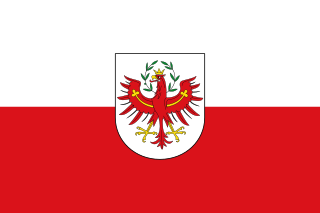
Tyrol is a state (Land) in western Austria. It comprises the Austrian part of the historical Princely County of Tyrol. It is a constituent part of the present-day Euroregion Tyrol–South Tyrol–Trentino. The capital of Tyrol is Innsbruck.

The history of Tyrol, a historical region in the middle alpine area of Central Europe, dates back to early human settlements at the end of the last glacier period, around 12,000 BC. Sedentary settlements of farmers and herders can be traced back to 5000 BC. Many of the main and side valleys were settled during the early Bronze Age, from 1800 to 1300 BC. From these settlements, two prominent cultures emerged: the Laugen-Melaun culture in the Bronze Age, and the Fritzens-Sanzeno culture in the Iron Age.

South Tyrol is an autonomous province in northern Italy, one of the two that make up the autonomous region of Trentino-Alto Adige/Südtirol. The province is the northernmost of Italy, the second largest, with an area of 7,400 square kilometres (2,857 sq mi) and has a total population of about 534,000 inhabitants as of 2021. Its capital and largest city is Bolzano.

Trentino-Alto Adige/Südtirol is an autonomous region of Italy, located in the northern part of the country. The region has a population of 1.1 million, of whom 62% speak Italian as their mother tongue, 30% speak South Tyrolean German and several foreign languages are spoken by immigrant communities. Since the 1970s, most legislative and administrative powers have been transferred to the two self-governing provinces that make up the region: the Province of Trento, commonly known as Trentino, and the Province of Bolzano, commonly known as South Tyrol.

Merano or Meran is a city and comune in South Tyrol, northern Italy. Generally best known for its spa resorts, it is located within a basin, surrounded by mountains standing up to 3,335 metres above sea level, at the entrance to the Passeier Valley and the Vinschgau.
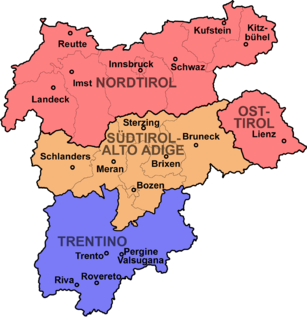
East Tyrol, occasionally East Tirol, is an exclave of the Austrian state of Tyrol, separated from the main North Tyrol part by the short common border of Salzburg and Italian South Tyrol. It is congruent with the administrative district (Bezirk) of Lienz.

The Citizens' Union for South Tyrol, formerly Union for South Tyrol, was a national-conservative political party active in South Tyrol, Italy.

The South Tyrol Option Agreement was an agreement in effect between 1939 and 1943, when the native German and Ladin-speaking people in South Tyrol and several other municipalities of northern Italy were given the option of either emigrating to neighboring Nazi Germany or remaining in Fascist Italy, where the German minority was subjected to repressive Italianization efforts.

Modern-day South Tyrol, an autonomous Italian province created in 1948, was part of the Austro-Hungarian County of Tyrol until 1918. It was annexed by Italy following the defeat of the Central Powers in World War I. It has been part of a cross-border joint entity, the Euroregion Tyrol-South Tyrol-Trentino, since 2001.

The (Princely) County of Tyrol was an estate of the Holy Roman Empire established about 1140. After 1253, it was ruled by the House of Gorizia and from 1363 by the House of Habsburg. In 1804, the county of Tyrol, unified with the secularised prince-bishoprics of Trent and Brixen, became a crown land of the Austrian Empire. From 1867, it was a Cisleithanian crown land of Austria-Hungary.
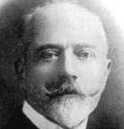
Ettore Tolomei was an Italian nationalist and fascist. He was designated a Member of the Italian Senate in 1923, and ennobled as Conte della Vetta in 1937.

South Tyrolean Freedom is a regionalist, separatist and national-conservative political party in South Tyrol, Italy. The party, which is part of the South Tyrolean independence movement, seeks to represent the German-speaking population and proposes the secession of South Tyrol from Italy and its reunification with the State of Tyrol within Austria. Its founding leader was Eva Klotz.

In 1919, at the time of its annexation, the middle part of the County of Tyrol which is today called South Tyrol was inhabited by almost 90% German speakers. Under the 1939 South Tyrol Option Agreement, Adolf Hitler and Benito Mussolini determined the status of the German and Ladin (Rhaeto-Romanic) ethnic groups living in the region. They could emigrate to Germany, or stay in Italy and accept their complete Italianization. As a consequence of this, the society of South Tyrol was deeply riven. Those who wanted to stay, the so-called Dableiber, were condemned as traitors while those who left (Optanten) were defamed as Nazis. Because of the outbreak of World War II, this agreement was never fully implemented. Illegal Katakombenschulen were set up to teach children the German language.

The Tyrol–South Tyrol–Trentino Euroregion is a Euroregion formed by three different regional authorities in Austria and Italy: the Austrian state of Tyrol and the Italian autonomous provinces of South Tyrol and Trentino.

Bolzano/Bozen railway station is the main station of Bolzano/Bozen, capital of the autonomous province of Alto Adige/Südtirol, in northeastern Italy.

Tyrol is a historical region in the Alps - in Northern Italy and western Austria. The area was historically the core of the County of Tyrol, part of the Holy Roman Empire, Austrian Empire and Austria-Hungary, from its formation in the 12th century until 1919. In 1919, following World War I and the dissolution of Austria-Hungary, it was divided into two modern administrative parts through the Treaty of Saint-Germain-en-Laye:
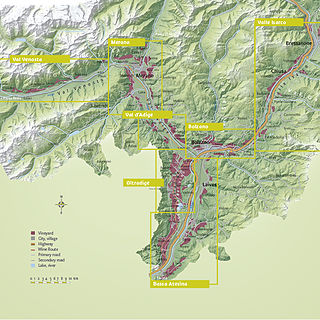
South Tyrol is an autonomous province located in north-east Italy producing wine. This Austro-Italian wine region is noted for the distinct Austrian influences on the wine industry due to the region's long history under the rule of Austria-Hungary and Holy Roman Empires.

Heinrich or Heinz Andergassen was an engineer, SS officer, and convicted war criminal who was executed for the torture and murder of seven Allied prisoners of war. He was a SS-Sturmscharführer and later an SS-Untersturmführer in Northern Italy.
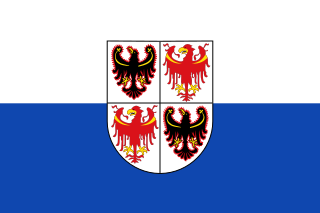
The flag of Trentino-Alto Adige consists of a coat of arms, containing two eagles of San Wenceslao (Trentino) and two Tyrolean red eagles, historical symbols of the two provinces, which stand out against a white and blue background. The shape of the flag is a rectangle with a framed heraldic shield on it. Like other flags, the flag of Trentino-Alto Adige is also inspired, albeit differently, by the French flag introduced with the revolution of 1789. When Napoleon's army crossed Italy, starting from March 1796, flags of tricolor style they were adopted both by the various newborn Jacobin republics and by the military units that supported the French army. In the Alpine region, however, sketches of the two-tone we know well today began to emerge. Trentino-Alto Adige has been a region with a special statute since 1948. The two parts that make it up, the Province of Trento and the Province of Bolzano, in turn constitute two provinces with particular prerogatives of autonomy defined in 1972. The white-blue flag, in use (limited) since 1995, takes up the characteristics of the banner, including the shield with quartered eagles from the province of Trento and that of Bolzano. White and blue are the colors on which the coats of arms of Trento and Bolzano respectively were worn in ancient times. It has never been legally defined, unlike the coat of arms and the banner, approved on 17 September 1982 and approved by presidential decree of 21 March 1983.
The Andreas Hofer Kreuzer, also called the Hofer Kreuzer or Sandwirtszwanziger, was the name of the 20- and 1-kreuzer coins that were minted during the Tyrolean Rebellion in Hall in Tirol in 1809. The obverse depicts the Tyrolean Eagle and the inscription Gefürstete Grafschaft Tirol; the reverse shows the nominal value.